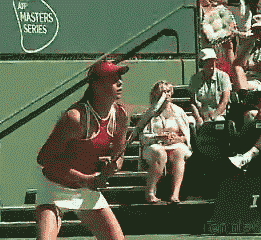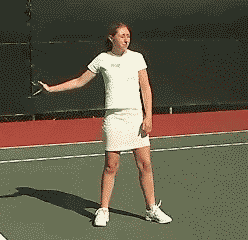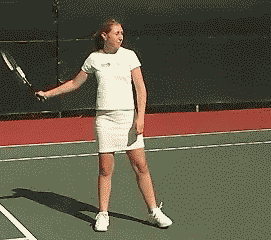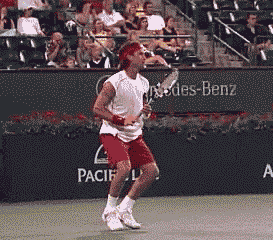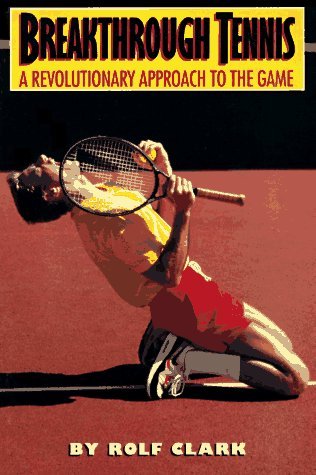|
TennisOne Lessons Timing and Your Wrist Rolf Clark
Nothing in tennis is more consistently damaging to your game than having your wrist flip forward as you meet the ball with your racquet. The ball loses speed and power and flies off in the wrong direction. Swing so Your Wrist Stays Fixed It is crucial to hit so your wrist stays cocked open the way it is when you start your backswing. The follow through should leave the wrist in the same cocked open position. The correct "cocked open" position (for the forehand) can be obtained by standing at the net, then pushing your racquet face into the net cord with your wrist "laid back." The racquet strings should be well out in front of you, as though you were making contact with the ball. Press the racquet face into the net cord. Find the position for your feet so that you can push hard against the net. Pressing the racquet against the net should now provide a powerful wrist position – where the wrist is laid back so the back of the hand is angled about 45 degrees to your forearm. That wrist position should be maintained throughout the swing sequence.
It's all right to use “wristy” shots when you play ping pong, say. The ball is light, the distance involved is small and getting the ball where and how you want it can be accomplished literally with the flick of a wrist. That doesn't work with tennis. On rare occasions -- such as when they're at the net and must react instantly -- good players with the necessary strength and control will meet the ball by flicking the racquet with their wrists. But even tournament players do not practice such wristy shots because they don't want to get in the habit of hitting that way. Your wrist will automatically stay fixed if you are balanced, swing with proper timing, and meet the ball well in front of you. One reason that hitting out in front is so important is that it allows you to keep your wrist fixed. Caution: Don't Confuse Cause and Effect Consider the following two statements:
The first statement is telling us that if you swing properly the wrist will remain fixed. It's a sound insight. The second statement offers poor advice. Contrary to what it implicitly promises, keeping the wrist fixed will not cause a good swing. A well-timed swing with the ball met in front of the body leads to a properly fixed wrist. But keeping your wrist fixed does not yield good timing. Hitting late causes a wristy swing. The wrist compensates for lateness by forcing the racquet through quickly. If you're late, it's easier to force just the racquet -- that is, to "wrist" it -- than to force your arm and racquet. Because the racquet weighs less than the arm plus the racquet, it can be moved more quickly. Therefore being late causes wristiness. Learn to swing so you're not late and your wrist will stay fixed. Shadow Hitting
To develop a perfectly timed fixed-wrist stroke, practice swinging your arm without holding a racquet. Pretend your palm is the racquet, and that you're hitting an imaginary ball with your palm. Let the imaginary impact point occur in front of your torso. Swing freely, like a pendulum. Swing several dozen times, but each time you swing, swing your arm so as to hit through the imaginary ball with your palm. Pretend your palm determines which way the ball will go. Hitting through the ball means accelerating through the impact point -- increasing your hand speed even after the impact point. As you swing your arm, pay close attention to your wrist. If you swing like a pendulum, meet the imaginary ball in front of you and accelerate your hand as you hit, then your wrist should remain cocked open (remain in a fixed position) throughout the swing. Now Swing a racquet Without a Ball Once you get the feeling of a well-timed, fixed-wrist swing with just your arm, try swinging with the racquet.
Again, swing at imaginary balls. But now think of the racquet hitting the ball with your palm leading the racquet. Hit as though you want the handle to lead the racquet head through the entire swing. Accelerate your hitting system -- arm, hand, and racquet -- through the imaginary impact point, with the racquet trailing your hand. Keep swinging smoothly, like a pendulum, as you do this. Your wrist should remain as fixed as it was when you were swinging without a racquet. Do a lot of this imaginary swinging. You can do it at home with your racquet, for example, while watching television, or with your fold-up umbrella while walking to work. It's important to swing perfectly without hitting a ball, until it's natural to do so without your wrist breaking forward even the least bit. Then you're likely to swing through the real ball the same way -- with your wrist naturally staying laid back. A Worthwhile Tip: "Butt First" I'm against most tips, but "pull the racquet through the ball butt first" is one tip that seems to work. That's because it focuses on an action. It keeps your mind on both the racquet and the ball. When the butt of the racquet handle is pointing at the ball on the backswing, then you are set up to hit "butt first." When you swing properly you should feel your hand pulling the racquet, handle first, so that the racquet head (the strings) actually trails behind your hand as you swing. That helps you hit with your wrist fixed, and allows you to accelerate through the ball.
Some people find it helps to think "pull the butt end of the racquet through the ball." By that I mean to think of pointing the butt end of your racquet at the approaching ball as you start to swing forward, and then pull the racquet straight through the swing, almost as though you were going to hit the ball with the butt end of the racquet handle. (Don't worry, the racquet head, not the handle, will hit the ball.) This works on ground strokes, on volleys, and even overheads. One student told me that "butt first" didn't make sense to her. So I suggested she think of hitting the ball with her palm or hitting handle first, or hitting with her hand pulling the racquet, or "hand first, racquet head last." One of these clicked, and she soon started pulling the racquet through the ball without using her wrist. You may need to experiment with the words until they make sense to you. Your comments are welcome. Let us know what you think about Rolf Clark's article by emailing us here at TennisOne.
|

